Themed collection Catalysis in Flow Chemistry

Editorial – Flow Chemistry and Catalysis
Editorial for the themed issue on flow chemistry in catalysis.
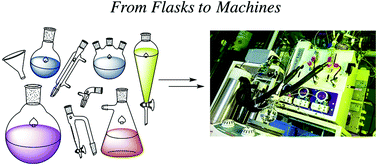
Catal. Sci. Technol., 2016,6, 4676-4677
https://doi.org/10.1039/C6CY90064J
Fine chemical syntheses under flow using SiliaCat catalysts
After reviewing selected recent applications from diverse laboratories, we show how mesoporous organosilica-entrapped catalysts of the SiliaCat series have been successfully used for clean manufacturing of APIs in a number of different reactions carried out under laminar flow in microreactors.
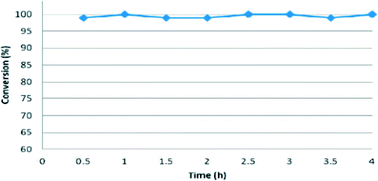
Catal. Sci. Technol., 2016,6, 4678-4685
https://doi.org/10.1039/C6CY00038J
Synthesis in mesoreactors: Ru(porphyrin)CO-catalyzed aziridination of olefins under continuous flow conditions
The Ru(porphyrin)CO-catalyzed addition of aryl azides to styrenes to afford N-aryl aziridines was successfully performed for the first time in mesoreactors under continuous flow conditions.
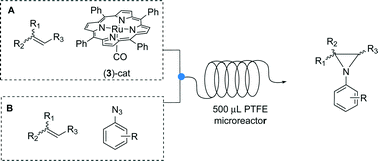
Catal. Sci. Technol., 2016,6, 4700-4704
https://doi.org/10.1039/C6CY00207B
Removing the superfluous: a supported squaramide catalyst with a minimalistic linker applied to the enantioselective flow synthesis of pyranonaphthoquinones
A new, cost-effective polystyrene-supported squaramide organocatalyst has been shown to mediate the highly enantioselective formation of pyranonaphthoquinones in flow through a sequential two-step process.
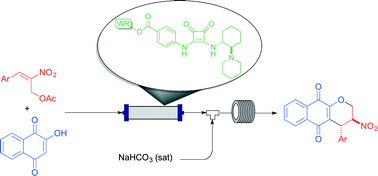
Catal. Sci. Technol., 2016,6, 4686-4689
https://doi.org/10.1039/C6CY00473C
Visible-light photoredox catalysis using a macromolecular ruthenium complex: reactivity and recovery by size-exclusion nanofiltration in continuous flow
A macromolecular Ru(bpy)32+ based dendrimer can be used as an efficient photoredox catalyst, retrieved from the reaction mixture by organic solvent nanofiltration and reutilized for further reactions.
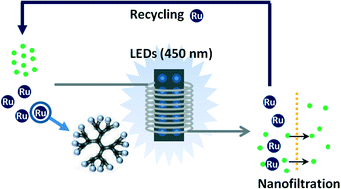
Catal. Sci. Technol., 2016,6, 4695-4699
https://doi.org/10.1039/C6CY00070C
Integration of borylation of aryllithiums and Suzuki–Miyaura coupling using monolithic Pd catalyst
Integration of the preparation of arylboronic esters and Suzuki–Miyaura coupling using monolithic Pd catalyst was successfully achieved.
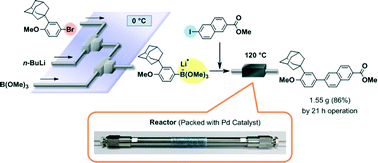
Catal. Sci. Technol., 2016,6, 4690-4694
https://doi.org/10.1039/C5CY02098K
Oxidation of cinnamyl alcohol using bimetallic Au–Pd/TiO2 catalysts: a deactivation study in a continuous flow packed bed microreactor
Deactivation of Au–Pd/TiO2 catalyst during oxidation in flow is attributed to Pd leaching and a complex effect of oxygen.
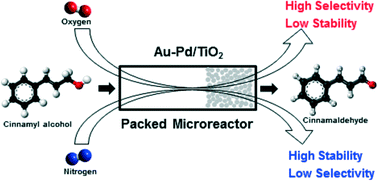
Catal. Sci. Technol., 2016,6, 4749-4758
https://doi.org/10.1039/C6CY00232C
Insights into the activity, selectivity and stability of heterogeneous catalysts in the continuous flow hydroconversion of furfural
The continuous flow hydroconversion of furfural to a range of furanic derivatives was carried out using a range of metal-containing heterogeneous catalysts in order to provide insights into the reaction pathways for the hydrogenation of furfural.
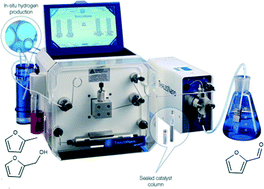
Catal. Sci. Technol., 2016,6, 4705-4711
https://doi.org/10.1039/C6CY00249H
Consecutive lipase immobilization and glycerol carbonate production under continuous-flow conditions
Several value-added products can be produced from glycerol and among these products glycerol carbonate (GC) has received much attention in recent years because of its physical properties and wide application in the chemical, pharmaceutical and food industries.

Catal. Sci. Technol., 2016,6, 4743-4748
https://doi.org/10.1039/C6CY00295A
Continuous flow Negishi cross-couplings employing silica-supported Pd-PEPPSI–IPr precatalyst
The synthesis of a triethoxysilyl functionalised Pd-PEPPSI–IPr complex prepared via azide–alkyne cycloaddition is described.

Catal. Sci. Technol., 2016,6, 4733-4742
https://doi.org/10.1039/C6CY00331A
Epoxidation using molecular oxygen in flow: facts and questions on the mechanism of the Mukaiyama epoxidation
Mukaiyama reaction was performed G/L continuous-flow microreactor. In less than 5 minutes at room temperature, cyclooctene was efficiently transformed to the corresponding epoxide using O2 as oxidant and aldehyde as co-reductant.

Catal. Sci. Technol., 2016,6, 4724-4732
https://doi.org/10.1039/C6CY00309E
Cu-catalysed pyrazole synthesis in continuous flow
By using supported Cu(II) catalysts for the regioselective synthesis of 1,4-disubstituted pyrazoles, we significantly reduced the Cu loading to 30 mol% and the alkyne required. Also, continuous flow allowed a dramatic reduction of reaction times going from 16 h to residence times of 5–15 min, being able to easily scale up this methodology.
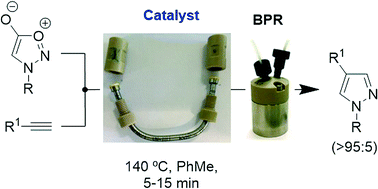
Catal. Sci. Technol., 2016,6, 4718-4723
https://doi.org/10.1039/C5CY02247A
Continuous ruthenium-catalyzed methoxycarbonylation with supercritical carbon dioxide
The methoxycarbonylation of cyclohexene with carbon dioxide over a ruthenium catalyst was realized in a micro flow system under supercritical conditions.
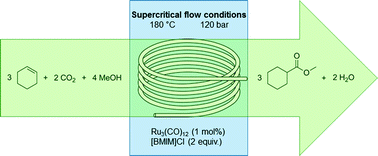
Catal. Sci. Technol., 2016,6, 4712-4717
https://doi.org/10.1039/C5CY01883H
About this collection
This themed issue, guest-edited by Steven Ley (University of Cambridge), features key contributions on the use of catalysis in flow chemistry applications. This important developing area of science encompasses homogeneous, heterogeneous and enigmatic systems, with an emphasis on using continuous flow based technologies.